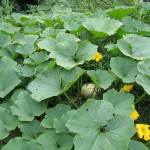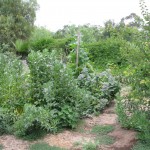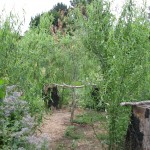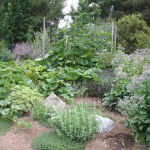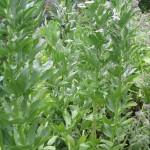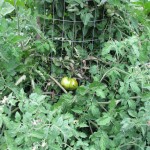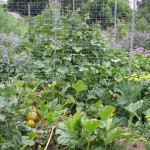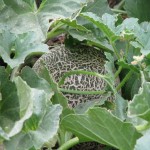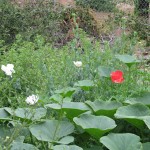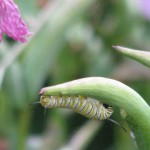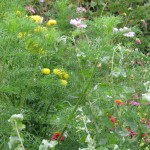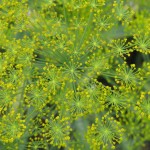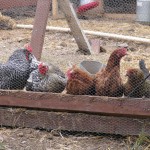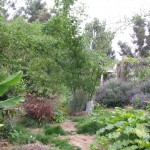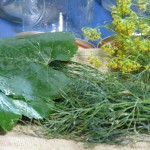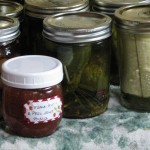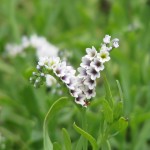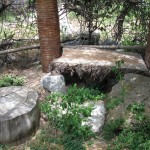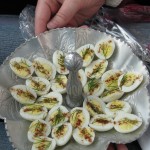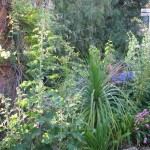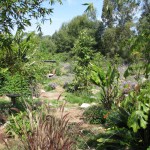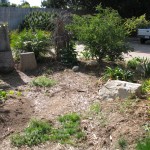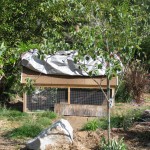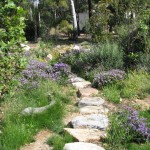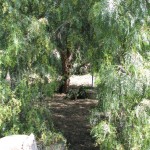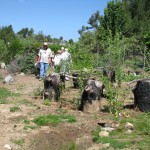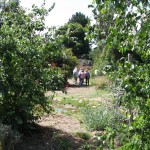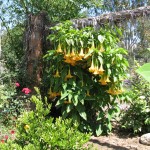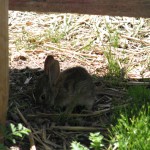- Animals, Chickens, Gardening adventures, Heirloom Plants, Herbs, Other Insects, Permaculture and Edible Forest Gardening Adventures, Photos, Ponds, Quail, Vegetables
What’s Happening in the July Garden
A banana squash stealthily growing huge An apricot tree with fava beans, squash, herbs, artichokes, and tomatoes The withy hide growing beautifully Kabocha and delicata squash on the ground, zucchino rampicante on the trellis, Christmas beans, favas, Swiss chard and medicinal plants around a small avocado tree Favas: great for the soil, great for the dinnerplate Heirloom tomatoes. Why do they all come ripe at the same time? Sugar pumpkins are ripe already in the Mediterranean guild. Also figs, paste tomato, dill, fennel, thyme, pickling cucumbers and artichoke. Plant guilds of squash, beans, flowers, etc. are flourishing. Heirloom green melons hiding from the hot sun. By now the wild buckwheat has dried up, which starves the bees. But not here. Matilija and Flanders poppies over banana squash Monarchs are so plentiful this year that we have to take pains to avoid them. Wildflowers host an incredible diversity of insects Dill flowers looking like a spectacular firework In a balanced wildlife habitat, bunnys do little harm All five girls waiting for treats in the Fowl Fortress Pumpkins, bananas, bamboo and much more by fescue paths. Fresh grape leaves, dill and garlic from the garden for the pickles Hot weather? Must be canning season! Pickled cucumbers, zucchino and onions, and peach pit and peel jelly. Very large yellow waterlilies Native salt heliotrope by the big pond. Volunteer tomato in the shade of the Nest, by palm tree bench. Wisteria, grapes and zerpheranthum lilies around the Nest Blooming banana Quail eggs! Double heirloom hollyhock Egyptian lilies Fourth of July rose celebrating the holiday - Compost, Gardening adventures, Permaculture and Edible Forest Gardening Adventures, Soil, Vegan, Vegetables, Vegetarian
Fava Beans
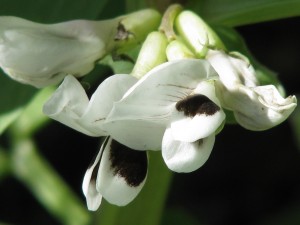
Fava flowers Have you ever eaten Italian, Greek or Middle Eastern food and found some enormous beans in it? Most likely those were fava beans. Commonly called broad beans or horse beans, these ancient beans are native to Africa and Asia, but can be found in cuisines worldwide.
There are a lot of reasons to grow them, even if you don’t eat the beans. First of all, they are nitrogen fixers, being a legume. However they don’t tendril like green beans do. The plant is a tall stalk (different varieties grow different heights) that sets beautiful flowers down the trunk. From these flowers grow some very weird-looking veggies. The pods look like clusters of swollen green fingers, I kid you not. The stalk can grow unsupported, but may topple over once the heavy pods are set.

Another reason to grow them is that they are hardy and can tolerate cold, and soils that are heavy in clay and salts (which pretty much describes my yard). Often broad beans are grown as a cover crop, then cut and allowed to decompose on the soil surface while the roots release the nitrogen under the soil.
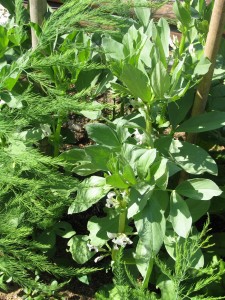
Then there is the reason that these very industrious plants produce an interesting protein-rich bean that enjoys notoriety worldwide (hence, easy to find different recipes for them!). The young leaves and flowers are edible as well.
To harvest favas, pull the swollen (but not too lumpy or they’ll be tough) pods from the stalks. Here comes the drawback: you have to shell the beans and it is a chore. Turn on a movie, pull up a bag of fava beans and an empty compost bucket, and go to. You may want to use a sharp knife to run down the seam, but I just used my fingernails. I watched the 1980’s TV show Cheers, which I never saw because I haven’t had television in about 17 years. Three episodes and I finished a big bag of favas!

When you’ve shelled the beans, you must blanch them for 3 minutes, then drop them in an ice bath. Rub the beans to remove a waxy coating. Then you can sautee them, mash them with potatoes, use them in fritters and soups, try an exotic Middle Eastern recipe with them. Fry them until they are crisp and serve salted as a snack. If you want to freeze them, then give the beans the blanch and ice water treatment, dry them and freeze them on a cookie sheet. Put them into a freezer bag. When you want to use them, then thaw, remove waxy shells and use. Some people don’t remove the coating, but its better if you do.
Fava beans have a nutty, slightly bitter and earthy flavor that becomes quite addictive. Two warnings, though. Some people, particularly those of Mediterranean decent, may be allergic. Also if you are taking anti-depressants, the beans are rich in tyramine and should be avoided by those taking monoamine oxidase (MAO) inhibitors – a type of medication used to treat severe depression.

Add fava beans to your garden and landscape. Just tuck the seed into the ground and stand back. Mine weren’t nibbled by rabbits or bothered by anything; however last year I grew six plants in a raised bed, and something opened all the pods and ate the beans. This year I have them planted all over the property to help build the soil, and the harvest appears to be all mine. I’m glad that Cheers ran so many seasons!

- Bees, Compost, Gardening adventures, Health, Heirloom Plants, Other Insects, Permaculture and Edible Forest Gardening Adventures, Soil, Vegetables
Integrated Gardening

Wildflowers, tasty borage, milkweed for the Monarch butterflies, and herbs. There are still those who prefer to have all their plants separate, each plant type confined to its own space. Vegetables should definitely not be allowed in the flower garden; herbs may be there only if more ornamental than useful, but don’t ever mix desert, country cottage or rose gardens together. That style of design is a matter of preference, and many gardens following those rules are very beautiful. They are usually also high maintenance, heavily fertilized, watered and sprayed, with poison set out for rodents.

A breadseed poppy is emerging in the sage. The blending of useful and ornamental plants is certainly not a new idea, and yet it isn’t often done. When it is, gardeners should find that the loss rate of plants to pests is quite low, and the yield of the vegetables is high.

Onions, native mallow, tarragon and sweet potatoes under a white fringe tree. Why is this? For one thing, planting mixed seeds which include ornamentals, herbs and vegetables masks the scent of the most yummy plants from its preditors. There aren’t rows of the same type of plant for the insects to find. Since different plants take up different nutrients from the soil, the soil isn’t depleted of one particular nutrient, so mixed plantings usually make for healthier and tastier plants.

My first tomatoes of the season, off of a volunteer along the pathway. Oh so yum! Wildflowers with cilantro, dill and basil not only are more successful and appealing to look at, but if let go to flower are excellent pollen sources for bees.

Young parsley, California poppy, cilantro and dill by rain lilies. Allowing desirable plants to reseed not only saves you money, but makes the new plant hardy and adapted for your particular garden.

Volunteers are welcome, such as this squash. Of course mixing plants is what an edible forest garden is all about, although the mixing isn’t random. Each plant serves a purpose. I use fava beans as a great edible nitrogen-fixer, along with other beans, peas, sweet peas, lupine, and nitrogen-fixing trees and shrubs. Artichokes grow quite large, and their leaves when cut and left on the ground make superb compost, as do the leaves of comfrey. Artichoke leaves keep growing back, and the plant will produce many very yummy artichokes. (Artichoke hint: wipe Vaseline around the stem below the bud to keep ants and earwigs from finding their way between the leaves.)

Artichoke and fava beans beneath an apricot tree. Melons and squash make an incredible ground cover during the hottest months. Their large leaves shade the soil surface and block evaporation. Remember that raccoons aren’t supposed to like going through squash vines, so plant them around your corn.

Green melon and corn by a variegated lemon (Sophie the dog by the car). Integrating your plants, especially when following the edible food forest guidelines, helps increase soil fertility (different plants remove different things from the soil). Mostly this is done by keeping the soil a more moist and inviting habitat for soil microbes and worms, but also by dropping their leaves which become mulch.

A guild: kabocha squash, heirloom squash and gourd (on wire) with onions interplanted to keep seedlings safe, along with something else that I don't remember planting, wildflowers, artichoke (under the milk carton for bunny protection), scented geraniums, lavender, borage, orgeano, sweet potatoes (not up yet), cowpeas, fava beans and Swiss chard by a small avocado tree. -
Edible Food Forest
This is a cheat blog, because I’m simply going to give you a link to a newspaper article. This is about land that has been dedicated to an edible food forest, which the public may enjoy. I hope it is the beginning of a new government trend to help feed the hungry. It also has a nice diagram about what a food forest may look like. Here it is: http://www.theepochtimes.com/n2/united-states/food-forest-takes-root-in-seattle-242907.html .
- Gardening adventures, Heirloom Plants, Permaculture and Edible Forest Gardening Adventures, Recipes, Vegan, Vegetables, Vegetarian
Kohlrabi: A New (Old) Vegetable
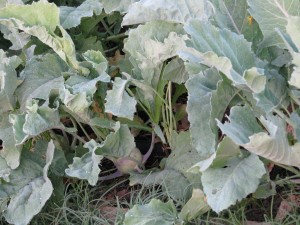
Cute hot air balloon veggie Once, my mother came home from the grocery store and was laughing about a woman who stood hands on hips in front of the produce section and announced, “I wish they’d come up with a new vegetable!”
I entirely sympathize.

The whole plant is edible! This year I planted a vegetable that I hadn’t grown, and perhaps had never eaten before. Kohlrabi. It certainly isn’t new; its been mentioned since Roman times and used on many continents. But it was new to me. The name is German, and it can be found in (East) Indian, Italian, French as well as Asian cuisine. It is very low in calories, yet very high in fiber, potassium and other vitamins and minerals.
It also is very cool looking. You can either imagine an alien, or a hot air balloon. The entire plant is edible, and can be eaten raw.
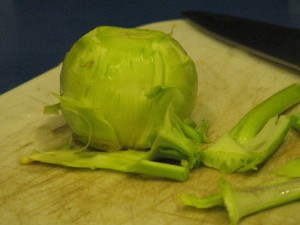
Peel the outer layer of older bulbs. When young, the leaves, stems and bulbous base can just be munched on, chopped up in salads, grated for slaw, used like jicama for dips, stir-fried, and even barbecued. When older the leafy parts should be separated from the tougher stems, like older chard leaves. The base should then be peeled before use.
The flavor is very mild, and is kind of turnip-radish-broccoli tasting. There are two types, a purple and a light green. I grew the light green, but have read that the purple variety is sweeter. I don’t know if that’s a good thing or not, but I may try that next year.
I braised and steamed the leaves, ate some of the bulb raw and stir-fried the rest. It was tasty. It was cute. It was fun to say. It was NEW.

Stir-fried kohlrabi with sesame oil and seeds, served with brown rice noodles and fresh orange. And, if you want to send a grocery store checker into confusion and hold up the line, buy some kohlrabi. They’ll have no idea.
- Animals, Bees, Birding, Chickens, Compost, Gardening adventures, Health, Other Insects, Permaculture and Edible Forest Gardening Adventures, Photos, Ponds, Quail, Rain Catching, Reptiles and Amphibians, Soil
I Went to a Garden Party….

AAUW Garden Tour Saturday was the AAUW Garden Tour. What a glorious day. I expected about a hundred visitors, and made 120 handouts. Sometime in the early afternoon I guess they ran out, and I didn’t know about it for awhile. I made 25 more for the last two hours, and have five left. One of the docents said that some had been turned back in during the morning. Every couple probably took just one… wow, that’s a lot of people.
I’d been talking to the garden all week, asking the blooming plants to hold that thought for a few more days, and encouraging the nonblooming ones to get a move on. The plants did what I asked! There were so many flowers out Saturday, it was amazing. Heirloom roses, Gideon’s Trumpet, ranunculus, herbs, wildflowers, and waterlilies. The garden, apparently, also was also all for proof in advertising, as in standing behind the NWF Habitat sign on the front gate. So many kinds of butterflies and dragonflies were out for the first time this year that people remarked on it. In the afternoon, there were sightings of a king snake all over the property; I think it had to have been three kingsnakes. One was moved from the refreshment area, but he came back, and then as I was standing by the pond talking to some ladies one came past us. Another was sighted up in the driveway. Roger sighted a gopher snake. No one shrieked or complained; either these were hardy people, or the idea that this was a habitat yard made them keep calm. It also backed up my claims of letting snakes deal with gophers and rodents! One man spotted a baby bunny under the Withy Hide bench. By one o’clock, it was funny. It was as if a button had been pressed to turn the garden on, and all the features were working! What a glorious day.
Jacob (Aquascape Associates) and Roger (landscape architect) and I answered questions for most of the day; the last four visitors left at four. So many people asked questions about permaculture, soil, beekeeping, cob ovens and rain catchment that I know that I couldn’t answer everyone’s questions. Of course there were some who like a tidy, orderly garden, and that is fine. If everyone came away with some idea how to work with nature rather against it, to use chemicals less, to grow organic food, to repurpose, to compost their kitchen waste and weeds, then what a lot of small ripples of good will come of it.
Thank you to my dear friends who helped prepare the garden so that it looked stunning. And thank you to the snakes, butterflies, bees, dragonflies, birds, bunnies and who-knows-what-else that came out to perform for the visitors! And thank you to everyone who visited! No casualities; all good.
Here are some photos, although my camera doesn’t do the colors justice:
AAUW Garden Tour Welcome! Look at photos of how it was. Main entrance walkway Walkway into the Nest One of the many trails A palm sitting stump between guilds by the driveway A green melon under variegated lemon, with native grasses. Quail hut, with privacy boards up. Status and wildflowers across the stone walkway Cool spot under the upper pepper tree Roger and visitors by the Withy Hide Some of the first visitors of many Pickerel blooming in the little pond Gideon’s Trumpet keeping blooms and aroma until the tour Jacob teaching about natural ponds Baby bunny under the Withy Hide bench Roger answering questions View from the Bee Garden gate Cool spot under the pepper tree -
What I Punch Now
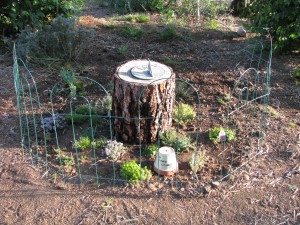
Sundial on the stump Its a Thyme Clock. So clever of me, I can hardly stand it. There is a sundial that I picked up at a thrift store, which sits on a stump. Around it are planted fourteen kinds of thyme! A Thyme Clock! I don’t have to punch a time clock at work… I can ‘punch’ (theoretically speaking that is) a Thyme Clock in my yard! (Or is the concept of a time clock too lost in history?). Ha!!!!
Sorry. Too much time in the sun (or should I say Thyme in the sun!) preparing for the Garden Tour tomorrow. I’m thinking its bedtime. Or bedthyme!!! No, it won’t stop anythyme soon. But it must, somethyme.
Sorry again.
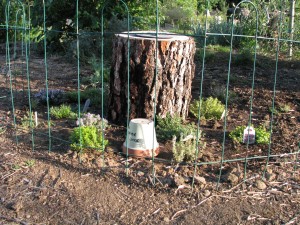
The Thyme Clock - Animals, Chickens, Compost, Gardening adventures, Permaculture and Edible Forest Gardening Adventures, Soil, Vegetables, Worms
Fifty Ways To Leave Your Compost

Its not fruit; its pre-compost! I have no idea how many years I’ve composted kitchen scraps. So many that when I see anyone dump veggie bits, egg yolk and shells, plate scrapings, old leftovers and even floor sweepings into the regular garbage it sets off all of my alarms. How can anyone waste all that good stuff? That is like throwing gold away! Its not dead stuff… its all living and ready to transform in to perfect soil, which shoots health into your plants! Most people say that they don’t have the time to compost, or they don’t want to turn a heap.
Well.
Here may not be fifty ways to compost easily, but certainly enough for ANYONE to keep their compostables out of the mainstream trash. And apologies to Paul Simon.
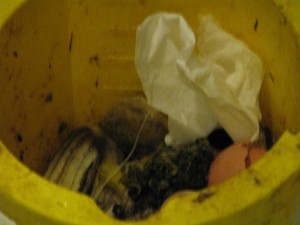
A blurry glimpse into my sink composting bucket. Egg shells, tea bags, banana peels, and tissues! 1. You Just slip out the back, Jack, with that little pail you have in or under your sink, into which you scrape everything compostable. They warn you about bones and meat because of animals digging through your heap to get to them, but if you bury your compost deeply, you won’t have that problem. I use a little bucket that they gave me for heaven-knows-what-reason at the hospital when I had my gall bladder out. It isn’t pretty, but it does the job. When I had both my children at home there was a lot more veggie peels to deal with, so in my kitchen I had a woven laundry basket, and inside I had two plastic liners, one for recycling and one for compost.

Big ol' basket, divided in half inside. One part recycling, the other compost. I only emptied it once a week. I didn’t like using so much plastic, but I’d put the plastic bag in the recycling. They sell all kinds of really nifty compost buckets now. Get one with a lid to keep those annoying little fruit flies from developing. Or if you have an open bucket like mine, just fill it partly with water so that the compost is submerged. It is easier to dump out that way and keeps cleaner, too. Especially if you’re going to…
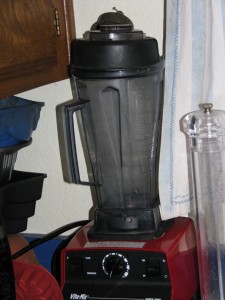
Is it a Vita-Mix, or is it a composting machine? Make a new plan, Stan, and instead of making a compost heap, you put all those scraps (barring big pits and nut shells) with water into a blender and whip it up. Then march outside and pour that brew around your plants! You can always kick a little dirt over it if its thick. This gives your plants a fantastic compost boost. Since it is undecayed pureed plant matter, you don’t want to bind up the nitrogen around seedlings or young plants, so pour it outside the drip line (how far the roots come out), or in an area you are preparing to plant in the future. This compost will decompose with days, depending on how warm the ground is (cold weather kills off or slows down microbes and wormies). If it is snowy winter where you are, then you might just freeze the stuff, in ice cube form or in paper cups. When the soil warms, plant those cubes! (Be sure to label them when in the freezer so no one thinks they are smoothie-pops!)

Freeze your blended compost, then empty the cubes into a bag and LABEL. You don’t need to be coy, Roy, but depending on your neighbors you may not want them to see you burying your compost. That’s right, you don’t have to make a heap, or blend it up. Just march outside with your bucket and a shovel or trowel, dig some small holes and bury it! The wormies will turn it into soil for you in weeks. Sometimes you’ll get surprises, like when a potato sprouts…. free veg! Here again for those who have frozen winters, you can pop the compost as is in a bag in the freezer. The only problem is freezer space. Just think, though, every bit you can save helps your garden!
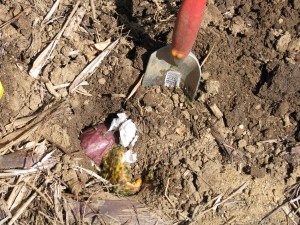
Dig it in! Just get yourself free from all your hangups about compost heaps and go buy a compost bin. I’ve a Rubbermaid bin for about twelve years. When my compost container is full I march it down, open the top, toss in the contents and away I go. When I pull weeds or thin the garden, I throw that in there too. Do I turn it? Heck, no! But if I wanted to I could very easily. The sides and two halves of the top fit together like enormous puzzle pieces, so I just need to take them all off, reassemble them right next to the heap, then pitchfork the compost back into it. The stuff that was on the top would now be on the bottom. Fresh compost can be shoveled out of a hole in the side on the bottom. Compost that is turned is not only matured faster, but is of a better quality and more broken down than that which isn’t turned. But as the bumperstickers say, compost happens! Stuff breaks down. Throw stuff into the top of the bin, and rake it out the bottom. Free your mind from compost regulations! Just go for it!

Throw it on! Compost happens! Hop on the bus, Gus, and become a real composter. You can build compost bins very cheaply. If you can nail things together so that they actually stay together (I can’t), you can build a three-section compost bin out of old pallets. There are lots of YouTube videos showing how. The best kind have removable slats in the front so that you can start low and gradually add to the front as the heap grows. Then when you want to turn it into the next bin, you may easily remove the slats for quick access. You can also just take a section of wire and make a cylinder out of it, then pitchfork in the weeds, grass, and throw in the kitchen trimmings. When its time to turn it, just undo the wire or slip it off, and set it up next to the pile again. Or have a line of wire cages. I have three, plus my bin. Do I turn them either? No. I keep throwing on excess weeds, and it keeps sinking down. Remember: compost happens!
You don’t need to discuss much with wormies because they can’t answer you: their little mouths are so full of your kitchen waste that they can’t talk! Make yourself a worm bin. Or buy one. You’ll need two dark plastic bins (one fits inside the other). Drill holes all through the lid for ventilation, and in just one of the bins drill some holes along the top of the sides, then drill tiny holes in the bottom for drainage. Fit the drilled bin inside the non-drilled bin. Put wads of newspaper, or paper from your paper shredder (unless you are saving it all to pack your mail-out Christmas gifts with instead of those nasty Styrofoam things) in the bin up to about half way. Lightly sprinkle with water. Throw a little soil in there, but not much for these kinds of worms. Find someone who has worms, or buy some red wigglers. You don’t want earthworms. Put these little guys gently into the bin. Take your compost and put it into one corner. Cover with a dampened sheet of newspaper and put the ventilated lid on the top. Keep the wormies from extreme temperatures. Some people keep a bin under their kitchen sink. Many school kids keep wormies as projects and for fun (baby wormies are white and wiggly!). As the wormies devour your compost they’ll leave behind castings, which look like sticky dirt. This is gold. If they had worm castings in Fort Knox instead of all that gold bullion our dollar would never fluctuate. What collects in the bottom bin is ‘worm tea’, which is just as valuable. Pour this stuff into your houseplants or directly on your plants. Commercial worm bins have several sections to hold more compost, are a little easier to manage and have a spigot for the worm tea. A perfect Mother’s Day gift! That or a compost bucket or bin!
Just drop off the key, Lee, with your housesitter when you go on vacation, and don’t forget to let her know to throw those kitchen scraps in with your chickens! Or goat! Or miniature pig! You don’t even need a heap when you have beaks! All those scraps are pure vitamins and minerals and chickens will not only devour them, but give you the best eggs you have ever tasted. Don’t forget to crush eggshells and give them right back to the chickens! They need that calcium to keep their eggs nice and hard. Chickens turn your compost into great eggs for you and great poo for the ground. Chicken manure can be used right away in your garden. Goaties will eat just about anything, as will piggies, so kitchen waste is perfect (slops).

Feed it to the chickens! And get yourself free from all that guilt that you shoulder when you throw food into the trash. Oh, and separate your recycling, too!
- Animals, Gardening adventures, Heirloom Plants, Permaculture and Edible Forest Gardening Adventures, Ponds, Reptiles and Amphibians, Soil, Vegetables
Earth Day at Finch Frolic
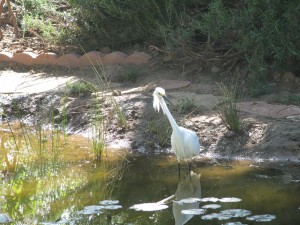
Snowy egret hunting. "Get the bullfrogs!" In celebration of Earth Day, I worked in the garden. You can stop laughing now. Yes, I know that I work in the garden nearly every day, and then spend time not volunteering or exercising, recovering from working in the garden. It was an overcast day, which beach-bound teenagers probably cursed, but I found perfect for working outside.

Roses in bloom everywhere. I had a visitor wishing me a Happy Earth Day.
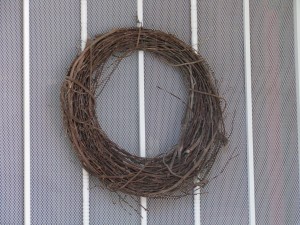
Do you notice anything about this wreath? This is an alligator lizard.
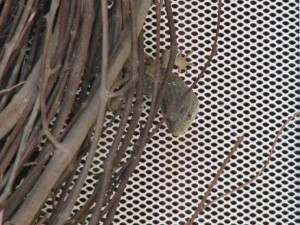
"Hello!" Hopefully he enjoyed the ride as I opened and closed the door several times to photograph him.
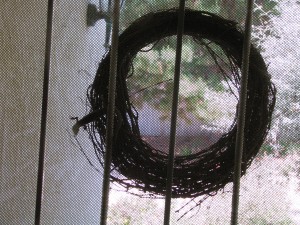
Alligator lizard from inside. Among other things today, I sifted compost. I had moved my compost bin, and this good compost was still on the ground from where it had been.
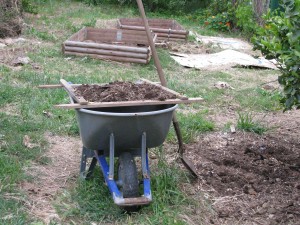
Sifting compost through a screen. I put it into a new raised (and wire-lined) bed.
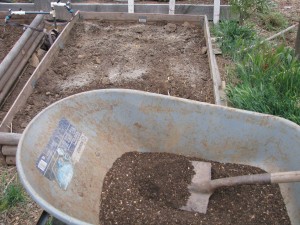
Adding sifted compost to the bed, which has been dusted with organic non-animal based fertilizer. Then I planted two rows of rice in it. Yes, rice. It is an heirloom variety from Baker Creek Organic Heirloom Seeds (http://rareseeds.com/rice-blue-bonnet.html), and it doesn’t need to stand in water to grow. Just something new and fun to try out.
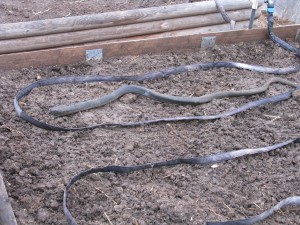
The rubber snake guards a freshly planted bed of rice. I’m also growing red seeded asparagus beans, the seeds of which were given to me by the woman who made the quail house. She also introduced me to Baker Creek, and for that I’m sincerely indebted. (http://rareseeds.com/red-seeded-asparagus-bean.html .)
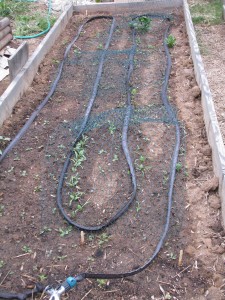
Spinach, carrots, edamame, sesame, Kentucky pole beans, endive and tomatoes are finally coming up. The other veggie beds are finally sprouting, now that the evenings have warmed up.
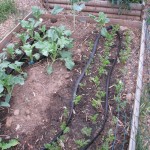
Collards and carrots, transplanted from another bed and doing well. 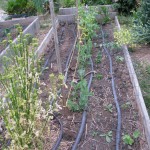
An incredible parsley setting seed, peas, parsnips, spinach, rhubarb, carrots and beans. 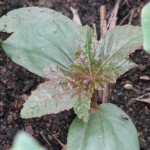
Castor bean seeds were in the mushroom compost, and I'm pulling them quickly. Here are a few views from other areas of the garden. Three weeds until the AAUW Garden Tour. Yikes!
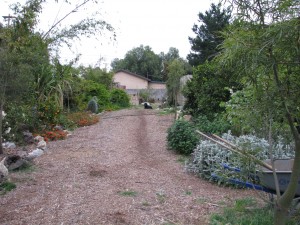
General Mischief waiting near the quail house for dinner. The hose connects to the 700 gallons of cootie water (compost tea) and is irrigating native plants. 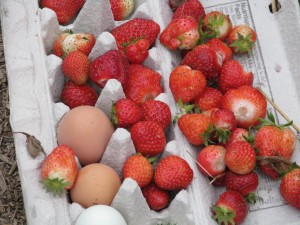
A happy harvest. Strawberries and eggs. I'm freezing the berries for later to make jam. 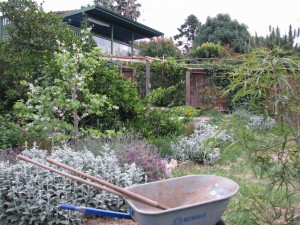
Lamb's Ear, whitebud, passionfruit and Bermuda grass 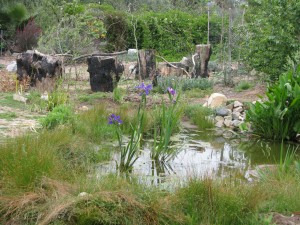
Stunning blue iris in the pond. 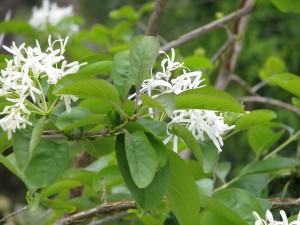
Fringe tree in bloom. 
Iris -
Soil: Weeding by Sheet Mulching
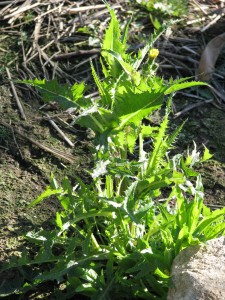
Sow thistle For this next part of how to build soil by weeding, I’ll discuss one of the easiest and laziest ways. If you want nothing to grow in an area, and don’t care about how it looks or length of time, then sheet mulching may be for you. I’ve used cardboard and newspapers around my vegetable beds with great success. To fully knock out tough weeds such as Bermuda grass, you should put down a good inch of newspaper or cardboard (or a combination). If you are using newspaper, leave the sections intact or else the wind will blow it everywhere, or cover it with a piece of cardboard. Water it in and let it rot.
If you have old plywood lying around, drag it over to your weed patch and pop it on top. Walk over it all you want, just watch out for old nails.

Sheet mulching with plywood... at work! Another method is to water your weeds, then cover them with thick black plastic held down with rocks. On hot days the weeds will cook under the plastic. I’ve used this before successfully, but now I would only use it if I had the plastic already. I’m trying hard to not contribute to the creation of more plastic.

The area after the plywood was removed. Then there is sheet mulching where you actually build your soil over the top of weeds. The new catch-phrase for this is lasagna gardening. Start with a layer of corrugated cardboard or three layers of newspapers (or a combination!) right on top of your weeds and where you want to plant (this isn’t for clearing pathways). Water this in really well. Then gather together compost items such as coffee grounds, weeds (without seeds), grass clippings, shredded paper, seaweed or algae… whatever you can compost. Sort your compost into browns and greens. Browns are mostly dead stuff such as leaves, shredded paper, pine needles and dried plant clippings. Greens are fresh things like dinner scraps, green cut grass… anything with some life still left in it. Manure is perfect for your ‘greens’ pile. Chasing down landscapers as they rake leaves and bag up grass from their lawnmowers is a good way to collect ingredients. Now start layering. The best ratio would be two parts brown to one part green, but don’t stress over it. The green stuff will heat up and cook the browns. Depending on how much stuff you can layer, your bed should be about two feet high, and however long that you want it. Water it regularly. Within weeks your lasagna will have sunk down into fantastic garden soil. If you want to plant right away, then add several inches of compost to the top. Otherwise, let it sit a season and you’ll be able to plant right into it. The newspaper or cardboard at the bottom will help suppress weeds and keep it moist. Remember that the deeper your loam, the more rainwater it will hold and the less you’ll need to water.
What all of these methods of weeding does, is to decompose the weeds right where they are. The minerals that they hold in their leaves are distributed into the soil, and as their roots decompose they leave tunnels for worms and other soil creatures to move around in. You are keeping the soil moist and dark, which are wonderful conditions for our soil friends to flourish. I’ve left plywood down on pathways during the entire growing season, and when lifting a piece have discovered treasures such as newts and salamanders underneath, that I wouldn’t have seen otherwis. They are great bug eaters for the garden. Sheet mulch also can harbor slugs and ants, but they are easily dealt with, especially if you have chickens!
Sheet mulching is very easy, it combats even tough weeds, it builds soil, and it repurposes things you might normally put into the trash. So save all those boxes from Christmas, the contents of your paper shredder, what newspapers you didn’t use to light the fireplace, your garden waste, your kitchen waste, and whatever your neighbors want to get rid of (tell them you’re making lasagna with it!) and begin layering. You are helping your garden, helping your soil creatures, building loam, opening underground stores of minerals for usage by plants, making your fruit and vegetables rich with nutrition, lightening your impact on the dump, creating a beautiful garden, and all without backbreaking work and certainly no chemicals! Just say, “NO!” to Monsanto!
